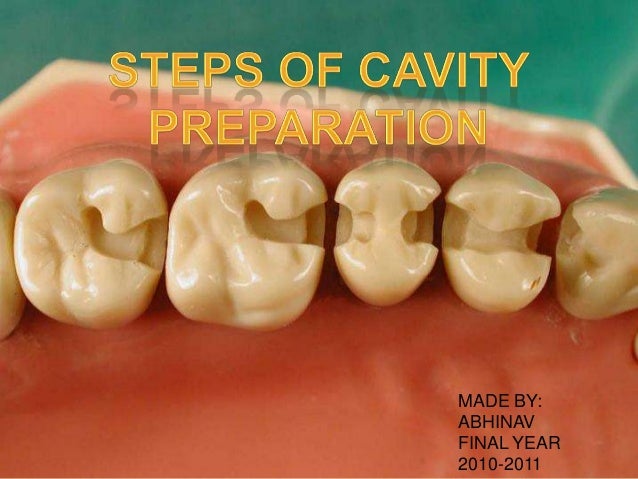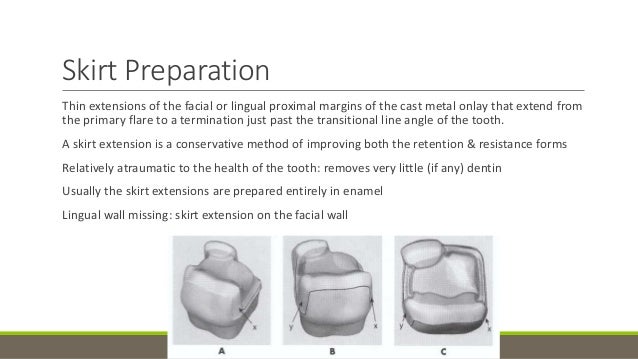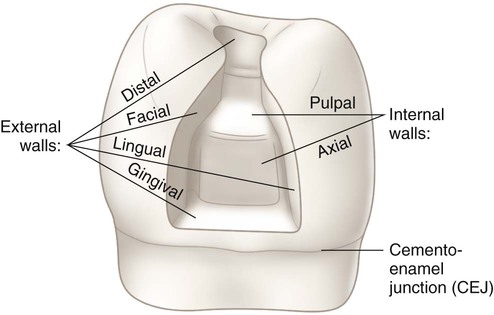Slot Prep Dentistry
OUTLINE FORM:
G .V. Black has described the outline form as being “the form of the area of the tooth surface to be included within the outline or enamel margins of the finished cavity”. It is the placement of cavity margins in the positions they will occupy in the final preparation, except for finishing enamel walls and margins and preparing an initial depth of 0.2 – 0.8mm pulpally of DEJ or normal root surface position.
Slot Prep Dental
Implant Dentistry. 3 Intracoronal Attachment Intracoronal attachments are incorporated entirely within the contour of the crown. Root preparation. Steps Of Cavity Preparation 1. STEPS OF CAVITY PREPARATION MADE BY: ABHINAV FINAL YEAR 2010-2011 2. DEFINITION OF CAVITY PREPARATION Cavity preparation is the mechanical alternation of a tooth to receive a restorative material, which will return the tooth to proper anatomical form, function, and esthetics.
II cavity preparation for use with dental amalgam in 1982. This preparation, which involves accessing caries by the facial approach, followed the instrumentation sequence used for Class III preparations. When first presented, the facial slot preparation was considered ultraconservative because it allowed the most direct access to caries. Class 2 slot preparation Matrix bands and retainers. Contour, insert and place wedge. Purpose: Restoration of proximal contact. Types: Tofflemire, T-band, compositight. Condensing and Carving of Amalgam. Using an amalgam carrier, add increments and condense using positive finger rest. Overfill prep and begin to carve and burnish the.
Two outline forms can be appreciated
- External outline form-which dictates the external perimeter of the outline form.
- Internal outline form-which dictates the inner dimension and detail of the cavity.
The factors that determine outline form are the following:
- Extent of the carious lesion.
- Extend the cavity margin until sound tooth structures obtained and no unsupported enamel remains.
- Margins should be paced in easily cleansable areas.
- Average depth of the cavity should be 0.5 mm into dentin.
- Extend the cavity margins into fissures that cannot be eliminated by appropriate enameloplasty.
PIT AND FISSURE CAVITIES
- The general factors mentioned above are to be followed. In addition the following are considered:
- Avoid terminating the margin on extreme eminences such as cusp heights and ridge crests.
- Circumventing of cusps should be followed resulting in a smooth free flowing outline form.
- In case of conservative cavity preparation shallow supplemental grooves and fissure crossing lingual or facial ridge can be eliminated by enameloplasty.
- When two pit and fissure cavities have been separated by less than 0.5 mm of sound tooth structure, they should be joined to eliminate a weak enamel wall between them.

PROXIMAL SMOOTH SURFACE CAVITIES
Occlusal cavity outline is same as above.
Gingival margins
According to G.V.Black’s concept the gingival margin should be placed 0.5 to 1.0 mm apical to the crest of healthy free gingival. Because this area was thought to be sterile due to the alkalinity of crevicular fluid and less chances of food impaction in this area, moreover the knife edge relationship of the healthy free gingival to the adjacent tooth surface will discourage food accumulation on the adjacent restored surface occlusal to the sulcus for considerable periods during and after food ingestion. But, Dr. John Me Call has shown that mechanical causes, systemic conditions and traumatic occlusion change the alkalinity of the crevicular fluid to an acidic form making it more prone to aciduric environment.
Emphasis is made to place the margin occlusal to or just clear of the margin of the gingival crest.
Facial margin and lingual margin
Slot Preparation Dentistry
The following factors govern them:
- Flare and mesiodistal width of embrasures.
- Wider and more flared the faciolingual embrasures are, less are the chances of food accumulation and therefore requires less extension facially and lingually.
- Caries index and oral hygiene.
- Faciolingual extension of the cavity in the corresponding embrasure is directly proportional to the caries index.
- Occlusal and masticatory forces.
- The more ideal the relationship between the adjacent and opposing teeth is, the better is the cleansability of the facial and lingual embrasures. Therefore, less extension is required.
- Age of patient and tooth structure and attrition of contact areas.
- An older tooth has higher fluoride content, is more resistant to caries and requires less extension.
- Creation of a more convex restoration.
- More convex restorations lead to wider embrasures and therefore less extension and better self cleansable areas.
Gingival margin is placed as in class II cavities. In young patients the margin is covered by the gingival whereas in patients with gingival recession the margins are kept supragingival. The mesiodistal extension is obtained considering the occluso-gingival convexity, occlusion and masticatory forces, caries index, and age of the patient.
Occlusal extension should not include the height of contour of facial and lingual surfaces.
MODIFICATIONS DUE TO THE TYPE OF RESTORATIVE MATERIAL
AMALGAM:
With the introduction of modern alloys, the modern concept of cavity preparation can be compared to the conventional G V Black’s design which are less time consuming, conserving and with decreased chances of failure.
CONVENTIONAL
OCCLUSAL PORTION- extension for prevention, mortise shaped with definite line angles and point angles.
PROXIMAL PORTION– either box type or truncated cone.
ISTHMUS-will not exceed 1/3rd intercuspal distance, atleast 1.5mm.
SWEEPING CURVES-given to the proximal and occlusal walls where they meet.
ACCESSORY RETENTION– proximal grooves are not so critical.
MODERN
OCCLUSAL PORTION:
- More conservative approach. Here G V Black’s concept of extension for prevention does not apply.
- Going around the cusps to conserve tooth structure.
- Not extending the facial and lingual more than midway between the central grooves and cusp tips.
- Using enameloplasty on the terminal ends of shallow fissures to conserve tooth structure.
- Margins of the facial and lingual class I involve the entire facial and lingual groove to avoid feather edged marginal amalgam.
PROXIMAL PORTION:
Only a unilateral inverted truncated cone on functional side of marginal angles to preserve tooth structure. The gingival margin should be located occlusal to the height of contour.
ISTHMUS:
Not to exceed 1/4th intercuspal distance.
SWEEPING CURVES:
Universal sweeping curve is exaggerated and more bulk is accommodated.
Slot Prep In Dentistry

ACCESSORY RETENTION:
Proximal grooves are used more often due to limited occlusal width.
TOOTH COLORED RESTORATIONS
Emphasis is more on conservative tooth preparation. G.V.Black’s concept of “extension for prevention” does not apply. With the introduction of acid etching phenomena by Buonocore, coupled with the use of synthetic resins has revolutionized the concept of cavity design.
Butt joint marginal configuration and placement of floor in dentin for retention were the characteristic features of conventional method. The modern concept is to include all faulty areas and conserve more tooth structure. Floor is not routinely placed in dentin. It depends on the caries extent and depth. Bevel is given on the enamel cavosurface margin. As in the conventional types, when a butt joint is made, a white halo is seen after the restoration is complete. This can be avoided by beveling the margin.
The ends of the enamel rods are more effectively etched than when only the sides are exposed to the etchant.
In case of composite resins the contact area should be maintained, left untouched as this material cannot maintain contact integrity, these materials can accommodate undermined enamel as long as it is not carious, discolored directly loaded in centric or eccentric contact or cracked.
CAST GOLD RESTORATION
The main characteristic feature in these restorations is taper and bevel incorporation in the outline form. The gingival to occlusal divergence of these cavity walls may range from 2 to 5 degree taper on each wall. The taper should be minimum in shallow cavities for better retention and resistance. The taper should be more in deep cavities for proper seating of the restoration. The taper prevents the undisturbed withdrawal of the wax pattern and subsequent seating of the casting.
Resistance form may be defined as that shape and form of cavity walls that best enable both the restoration and the tooth to withstand occlusal forces without fracture.
Fundamental principles involved are:
- Box shape or mortise shaped with flat floor, which helps the tooth to resist occlusal loading by virtue of being at right angles to the forces of mastication.
- Slightly curved than acute line angles decrease the stress concentration of stresses and hence reduce the incidence of fracture.
- Conservation of strong cusps and ridges with sufficient dentin support. Weakened areas should be included in cavity preparation to prevent fractures (capping of the weakened cusps).
- To provide enough thickness of restorative material to prevent fracture under load.
- Slight roundening of the line angles to prevent stress concentration.
STRESS PATTERNS OF TEETH
According to Gabel application of mechanical principles to the design of restorations will help conceive favorable stress patterns for the teeth and the restorations. These principles vary according to the type of restoration and cavity.
TYPE OF RESTORATION:
The minimal thickness of amalgam and cast gold to resist fracture is approximately 1.5mm, though a little more depth is required for amalgam to achieve the requisite bulk. However in composite and glass ionomer, the depth is not the criteria for achieving resistance form. Porcelain also requires a depth of 2mm for inlays and 1.5mm for crowns.
TYPE OF CAVITY:
CLASS I:
A flat pulpal floor is appropriate. In case of deep caries where a rounded pulpal floor may result, the stress is doubled in the deepest portion of the cavity. Fractures in these rezsstorations are due to insufficient dentinal thickness in the center. Bending stresses are proportional to square of depth. Therefore for large restorations depth should be increased with increase in diameter.
CLASS II:
A proximo-occlusal inlay restoration acts like a curved beam of cantilever type. Due to differences in modulus of elasticity of dentin and the material there will be displacement of the restoration in the gingival seat area with the axio-pulpal line angle as axis of restoration. This is prevented by a lock in the form of groove pins, etc in the gingival floor. In M.O.D. cavity axio-pulpal line angle should be more rounded.
CLASS III:
Due to the thickness of incisal edge the cavity is extended lingually as close to the incisal edge as possible.

CLASS V:
The functional cusp and functional fossa relationship dictates the stress pattern.
EFFECT OF GROOVES:
Grooves provide resistance to a certain degree. Courdadee and Jimmerman have shown that localized areas of stress are produced in tooth tissue by provision of supplemental intracoronal retention in the form of pins.
Louis Napolitano, DMD, shares a case in which a hard- and soft-tissue laser was used for granuloma removal and apicoectomy with a bone graft.
At a time in history, traditional dentistry had a place in all aspects of practice simply because that is what dentists knew. However, it is a new day, and the profession is in a different place. Now everyone is fortunate to have dental technologies at the ready that make everyday procedures—and those we might not have been able to perform before—much easier and more efficient.
One procedure that no longer has to be referred out or looked at as a burden is fibroma removal. With traditional instruments, such as the scalpel, these surgeries are not favored by most dentists. They can be very messy due to blood and are laborious. Additionally, suturing the surgical site adds an extra step and can be difficult. The patient experience also suffers as a result of prolonged time spent in the chair and postoperative discomfort.
Some technologies currently on the market can help erase the stigma surrounding fibroma removals and other tedious soft-tissue surgeries. One is Solea, a 9.3 µm CO2 dental laser that cuts bone, dentin, enamel, and gingiva. Below is a case in which the laser was used during an extensive granuloma removal and apicoectomy with a bone graft procedure.
Case summary
The patient, a 63-year-old female, presented for an emergency visit. She explained her situation, complaining of pain and a lump on the top-left quadrant of her mouth. After an oral evaluation and x-ray (figure 1), it was discovered that she had a large draining granuloma with swelling in the mucobuccal fold near teeth Nos. 12–14 due to a chronic periapical abscess (figure 2).
Figure 2: Pre-op

Clinical objective
The objective was to remove the granuloma at the junction of keratinized and elastic tissue, as well as the periapical pathology, without perforating the sinus on tooth No. 13.
Technique
Aiming the laser at the affected area at a 45-degree angle, the first step was to remove the fibroma (figure 3). This was done easily after choosing the appropriate spot size, mist, and power. Following removal, the selections were adjusted for the next step, which was to make an incision in the gingiva. Keep in mind that it was vital to leave approximately 2 mm of keratinized tissue and raise the flap at this time. The laser’s precision allowed for the precise cutting that was needed.
Figure 3: Immediately post-op
Continuing to adjust spot size, mist, and power as necessary, the laser was used to enlarge the fenestration in the buccal plate (figure 4). The granulation tissue from the abscess then had to be removed in order to expose the root for amputation. Simultaneously, a slot prep was cut for retrograde bioceramic restoration (figure 5).
Figure 4: Immediately post-op
Figure 5: Immediately post-op
After using a round burnisher and blow test to determine that there was no perforation to the sinus and the membrane was still intact, the laser was used at a spot size of 1.25 mm, on low power mode, and without mist or air to debride the medial superior area of the bony defect. X-rays were taken following immediate placement of bone-graft material to display the site after using Solea to remove bone and granulation tissue (figures 6 and 7). The entire procedure, including the bone graft, took approximately 40 minutes from start to finish.
Figure 6: X-ray immediately after placement of bone-graft material
Figure 7: X-ray immediately after placement of bone-graft material
Advantages of using a 9.3 µm CO2 dental laser
Setting aside the scalpel and using a 9.3 µm CO2 laser for this type of hard- and soft-tissue surgery offers advantages in procedural convenience, safety, and patient experience. In this case, the procedure was performed virtually blood-free, which allowed for a clean site that made treatment simple.
The laser also made ablation of the bony structure easy. If a conventional handpiece or piezo had been used, the cutting would have been nowhere near as seamless or precise. The infected granulation tissue was removed quickly and safely. Another issue that could have occurred was perforation of the patient’s sinus. With traditional instruments, this would have been more likely to happen, causing adverse effects. Using the laser, perforation was not a concern.
From a patient perspective, a 9.3 µm CO2 laser can dramatically change the dental experience. In this case, chair time was reduced (compare 40 minutes using the laser to the 60–90 minutes required by traditional dentistry), and the patient did not have to worry about excessive blood or postoperative pain. Healing was also rapid without any gingival defects.
During post-op visits, final results at the three- and eight-month marks and x-rays taken at eight months revealed optimal outcomes that met the clinical objective (figures 8–10).
Figure 8: Soft tissue at three months post-opFigure 9: Soft tissue at eight months post-opFigure 10: X-ray at eight months post-op
Louis Napolitano, DMD, graduated from Georgetown University in 1977 with a BS in chemistry and earned his doctor of dental medicine degree from Rutgers Dental School in 1982. He completed his general practice residence at Jersey Shore University Hospital and has been in private practice in Jackson, New Jersey, since 1983. Dr. Napolitano has been performing laser dentistry with Solea for four and a half years. He can be contacted at (732) 905-2488 or info@louisnapolitanodmd.com.